Harvard researchers have developed a soft-bodied robot, based on a starfish, that can camouflage itself when required – or color itself brightly.

Its ‘dynamic coloration’ system, says the team, could be used for everything from helping doctors plan complex surgeries to acting as a visual marker for search crews following a disaster.
“When we began working on soft robots, we were inspired by soft organisms, including octopi and squid,” says post-doctoral fellow Stephen Morin.
“One of the fascinating characteristics of these animals is their ability to control their appearance, and that inspired us to take this idea further and explore dynamic coloration. I think the important thing we’ve shown in this paper is that even when using simple systems – in this case we have simple, open-ended micro-channels – you can achieve a great deal in terms of your ability to camouflage an object, or to display where an object is.”
The color layers used for the camouflage start as molds created using 3D printers. Silicone is poured into the molds to create micro-channels, which are topped with another layer of silicone. Colored liquids can be pumped into the channels, changing the robot’s colors.
The layers can either consist of a separate sheet on top the soft robots, or be incorporated directly into their structure.
And the system’s camouflage capabilities aren’t limited to visible colors – pumping heated or cooled liquids into the channels meand they can be camouflaged in the infrared too. They can even be made to glow in the dark.
Morin also sees uses for the robots during search and rescue operations.
“What we hope is that this work can inspire other researchers to think about these problems and approach them from different angles,” he says.
“There are many biologists who are studying animal behavior as it relates to camouflage, and they use different models to do that. We think something like this might enable them to explore new questions, and that will be valuable.”






